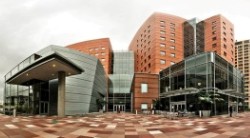
While some might think of edtech as a means for administrators and teachers to manage rosters and grade reports, education technology functions as any program, app, or tool which can assist in implementing pedagogical goals. Students, administrators, and teachers can all take advantage of data aggregation and instant communication to not only track academic performance, but also to protect student safety. With 71% of students reporting bullying as a problem at their school, the adults who care for them are eager to use any weapons at their disposal to make the school environment a safe one.
Anonymous Bullying Reporting
Some schools or districts offer anonymous bullying reporting. This innovation allows students to alert administrators to bullying, without fearing reprisal or the daunting prospect of telling a powerful adult face-to-face (possibly upsetting) details about a painful experience or situation.
These programs ask for specifics about the incident or incidents a student may have witnessed. They are usually linked on a district’s or school’s home page, and lead to a form which a student can fill out to provide details on the incident or circumstances. The programs ask for such information as the students involved, the location of any incidents, and the names of potential witnesses.
Anonymous bullying reporting can be used to alert administrators to physical, verbal, or cyber bullying. By allowing faceless communication, this option allows students to speak out while lowering fear of potential peer retaliation.
Keyword Alerting
The bulk of educational communication takes place electronically, both in the classroom and offline. Students and staff members rely on grading technology, plagiarism checkers, and electronic texts to enhance information delivery and retention stability.
But another kind of electronic communication takes place in the educational environment as students move throughout their day—texts sent to friends, updates to social media, and searches in online directories. When a keyword trigger such as “cutting” or “eating disorder” trips a school or district’s alarm, administrators are sent an alert. They can then assess the situation.
What adds to keyword alerting’s intuitive nature is that it provides context for the situation in which it was typed. Word cloud technology can indicate spiking issues across groups of students. Keyword alerts which take place in a classroom environment as part of an assignment register as low priority—if, for instance, a student types “euthanasia” into a word processing document which was open during an ethics course.
But if a student searches, for example, ways to hide anorexia during educational “down time” — between classes, during lunch, and throughout sports practices—and has previously reported being bullied about his or her appearance, administrators can delve more deeply into the dynamics of the student’s social media presence and ways he or she operates around peers. This kind of preventive action can help address suicide threats or potential bullying environments.
Cyberbullying in Educational Environments
As recently as one generation ago, students found a refuge from school bullying at home. But in the digital era, when communication has no off switch, adults must be forever vigilant.
Cyberbullying has become a rising concern for parents and educators. In cyberbullying, victims are harassed via texts, public forums, social media, chat apps, or gaming messaging systems. The bullying may take place in a disorganized fashion, or as part of targeted harassment. It can take the form of posting hateful comments on social media accounts, encouraging self-harm, posting threats, spreading photographs, or even starting a website dedicating to demeaning an individual child or social group.
Because students can dodge parental involvement using these systems, and children may be reluctant to report it for fear of losing electronic privileges, cyberbullying can often go undetected.
Blocking Technology
Many parents try to keep an eye on their childrens’ online activities via blocking technology. These are placed on child’s phone, computer, or tablet, and may come in the form of control apps, monitoring software, or alert systems. Is blocking technology applicable on a school or district wide basis?
It can be, but on an individual basis. Some programs which, for instance, filter certain keywords can unintentionally limit students’ educational experience. Many students find a way to be two steps ahead of even the most cutting-edge tracking technology, especially since the appropriations process, decision procedure, testing phase, and rollout within educational systems can take some time.
School districts which receive federal funding must by law provide at least filtering technology, and educators admit that blocking technology isn’t perfect. However, as blocking technology becomes more intuitive and some classrooms turn to digital citizenship awareness in addition to electronic controls, investing students with personal responsibility also help can provide a supportive learning environment.
Online Mentoring
In the event a student feels he or she cannot find support within his or her school, or don’t feel comfortable speaking to an adult, online mentoring might be an option. In online mentoring, students can remain anonymous, but still seek counsel. Some programs pair bullying victims with other young people who are trained to provide a listening ear. Adult counselors can also be on standby to provide professional assistance.
Some mentors are in middle school, but others can be college-age. Some online mentoring systems use public message boards; others rely on private chat. A few provide a hybrid of both.
Online mentoring can be combined with face-to-face peer mentoring. Mentoring can provide students with an opportunity to learn from and model themselves after older students who may have also been victims of bullying. This provides students with a consistent, comforting individual who provides the student with encouragement and inspiration. Many systems allow students to choose their mentors, either within his or her school system or outside of it.
Online peers can help their fellow students find the courage to report bullying. They can also help assist shy or awkward students in developing social skills. Such programs might also provide mentors with the ability to identify and defuse bullying within their own circles.




